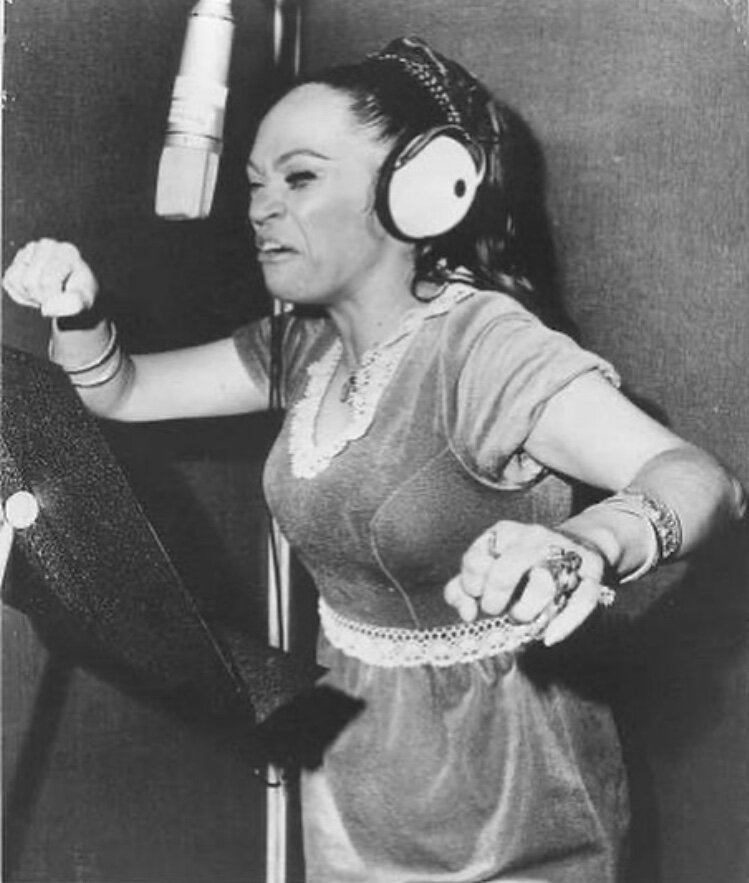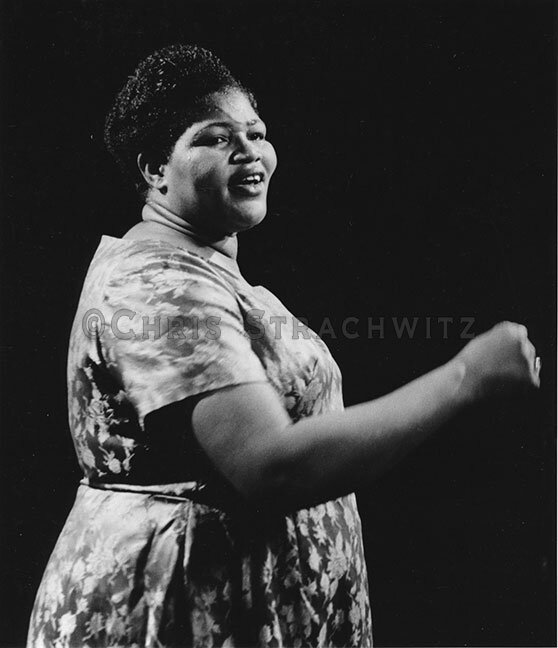By Francesca Harding
Let’s talk about Guadalupe Victoria Yolí Raymond. Stage name La Lupe. Nickname
La Yiyiyi. Rightfully named the Queen of Latin Soul. A firecracker of a woman with a voice electrifying beyond comprehension.
La Lupe gained massive recognition as a singer of boleros, guarachas and Latin soul in the late 1950’s and into the 1970’s, first in her home country of Cuba and again in New York City soon after immigrating to the States. She was a hurricane, a Santería-practicing wild woman known just as much for her controversial shows as she was for her magnetic voice. At the peak of her career she was the first Latin artist to sell-out Madison Square Garden, was twice voted “best singer” by the Latin press, helped to pioneer the ascendance of salsa music that exploded across the globe and enjoyed a level of acclaim that no other Latin artist had previously achieved in the U.S. But as quickly as she became a household name, her career was ripped from beneath her: issues with her record label, specifically their decision to pull financial support in favor of a rival, more demure singer spelled the end of La Lupe’s decades-long run. In the end, La Lupe represented an identity that was too raw, too unrefined and quite frankly too Black for a prejudiced society and was punished for it, cast aside as quickly as she had been exalted.
She was born in the small barrio of San Pedrito, Cuba on the 23rd of December 1936. Described by her sister Norma as “just another Black girl that no one paid attention to”, Lupe was an earnest child who loved to sing and dance and to chase behind musicians as they performed in the streets of her neighborhood. In 1954 while on pace to earn a degree in teaching, the teenaged Lupe is said to have walked from her hometown to Havana in order to enter and eventually win top prize in a singing contest by impersonating the popular Cuban singer of the time, Olga Guillot. Lupe’s win not only allowed her to sing on the radio but to also meet Guillot in person, forever changing her life’s trajectory. The veteran singer’s advice to the budding vocalist: find your own sound, find your own personality. Guillot’s foreboding words resonated deeply and Lupe went on to hone a never-before-seen style that catapulted her to stardom. Soon after her contest-win she joined the trio Tropicuba as a vocalist and also married the band’s leader, Eulogio “Yoyo” Reyes. Tropicuba enjoyed success in Havana’s nightclub scene where rumba, jazz and tango mixed to create nightlife unlike anywhere else in the world. However, at the height of Tropicuba’s popularity and amidst a tumultuous marriage full of cheating and abuse allegations, Lupe was fired from the group. In response, she at last launched a solo career, vowing to make something of herself without her now ex-husband’s help. The magic of La Lupe was born.
To watch La Lupe perform was to witness the convergence of the everyday world and the spirit world in real time. She’d take the stage, steadied and relaxed. As the show progressed and the music quickened, she appeared to summon the ancestors with every note she sang, every shriek and howl that would escape her throat, every thrash of her arms, pull of her hair and shake of her legs. She’d sensually rub her breasts while mimicking the sound of an orgasm, lift her skirt, physically hit her accompanying pianist to play faster – she was a sensation. By the show’s end, her wig, rings and clothes would be strewn around the stage (and in later years a medic would await her backstage with an oxygen mask because her performances would thoroughly deplete her). Now a regular performer at Havana's fashionable La Red nightclub, her unique voice and notorious stage shows were the stuff of legend. All the while, audiences were thrilled or appalled and sometimes both, unsure of what they were witnessing, but unable to deny that it was spectacular. As the story goes, Lupe was eventually warned that Fidel Castro considered her “antics” on stage anti-revolutionary and unsuitable for Cuba. Rather than conform, she fled.
After a brief stay in Mexico, Lupe arrived in New York City in 1962, unknown and penniless. But just as her name caught on like wildfire in Havana, much the same happened for her in NYC soon after her arrival. She linked with fellow Cuban musician Mongo Santamaría who immediately recognized her dynamism and began to incorporate her as front woman within his live shows. Being introduced to Mongo’s well-established fan base was lightning striking twice for the soul singer. Their joint 1963 album "Mongo Introduces La Lupe" solidified her as a star once again. She then caught the attention of legendary musician and record producer Tito Puente who didn’t waste any time in ‘stealing’ Lupe away from Mongo. Forging a new partnership with Tito Puente was, on its face, another solid step for her career. The two had undeniable chemistry in both the studio and on stage – Lupe gave Tito’s band edge; Tito attempted to polish some of Lupe’s unbridled energy. Born out of this tension were ballads like Que Te Pedi, their biggest hit together. Four, successful full-length albums later, their relationship ultimately soured. Some allege that Tito Puente couldn’t handle her star eclipsing his. Others point to Lupe’s unpredictable behavior as the source for their rift. Whatever the case, the two parted ways by 1968 and with the blessing of her label Tico Records, Lupe was once again a solo artist.
She forged ahead, recording some of her most classic hits such as La Tirana and Puro Teatro. Never fully without controversy, she fought rumors of drug use, dealt with an increasingly divisive relationship with her second husband who was diagnosed with schizophrenia, and was continuously shunned by many for openly practicing Santería. And then there were her risqué performances, one of which resulted in her being banned from Puerto Rican television for tearing her clothes off during a live broadcast. When the decision was made to sell Tico to Fania Records in 1974, her career’s decline could not be stopped. Company executives at Fania chose to pour resources into the more demure and less-controversial Celía Cruz; a half-decade later, La Lupe was living in destitution.
By the time of her death in 1992 from a massive heart attack at age 55, La Lupe had sworn off secular music and rebranded herself as a gospel singer and evangelical preacher. A deep dive on YouTube uncovers old, grainy videos of an aged, tired Lupe dressed in modest clothing and perched in front of a pulpit sharing her newfound commitment to the gospel. Gone were the heydays of Lupe the Latin soul singer who represented ferocity while remaining soft, who was both feminine and masculine, partly unhinged but always in complete control. Gone was the Lupe who seemed to be all things at once yet still somehow managed to remain un-definable. Considering how much she gave the world while alive, there was a shockingly lukewarm response to the news of her death. Her passing didn’t make the cover of mainstream news publications, parades weren’t held in her honor. An icon that had always made such impact somehow died much more quietly than she had ever lived. And the question we’re left pondering is how? Or perhaps it’s what - what made La Lupe disposable where she once had millions of adoring fans?
In surveying her rise and fall it would seem that respectability politics were always at play, throughout her career and surely up until her disappearance from the public eye. She paid the ultimate price for representing a cultural identity unaligned with European standards of etiquette. Whatever the acceptable version of a Black Latina may have been, La Lupe was not that. She was as fiery as she was loud in the way she held space for her art and her background. Before her conversion to Christianity, she had openly practiced a religion much too African to merit any type of respect from an intolerant, general public. La Lupe fell victim to the ageless practice of society deeming anything falling outside of proximity to whiteness as unworthy. That Fania Records had two massively successful artists signed to their roster but chose to work with Celía Cruz – who was seen as regal and sophisticated – while blatantly turning their backs on La Lupe was a painful reminder that society insisted on dictating the type of Blackness that was worthy of celebration and promotion. Years later, not much has changed.
Earlier in her career, La Lupe shared her perspective on why she tended to make audiences uncomfortable. She proposed that it likely stemmed from her doing “what they'd like to but can't get free enough to do”. And that was La Lupe, who moved to the beat of her own drum regardless of the consequences and in doing so, gave everyone around her permission to do the same. Before La Lupe’s untimely death she recorded more than twenty albums, was a household name all around the world and inspired the stage show of generations of performers who would come after her. It was in the way that she gave of herself completely and without restraint that makes the legacy she has left behind so tremendous. While our society still struggles with fully accepting Blackness in all of the ways that it is vast and varied, the levers of power continue to shift in the direction of those who refuse to be silenced or cast aside on racist whims. While we fight to hold space of our own, we do it in the name of the likes of Guadalupe Victoria Yolí Raymond, unapologetically Black, forever wild and free.





